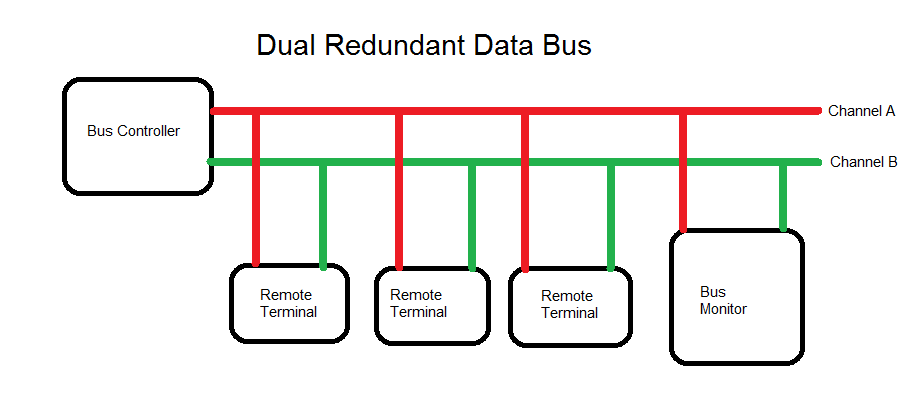What does MIL STD 1553 Stand For?
MIL STD 1553 is a US Military Department of Defence standard initially published in 1973. It defines the mechanical, electrical and functional characteristics of a Serial Data Bus – a communications system used primarily by military vehicles that transfers data between components sequentially, one bit at a time. Although originally designed for military avionics, the 1553 Serial Data Bus is now commonly used on military and civil spacecraft and on-board data handling subsystems such as the James Webb space telescope.

MIL STD 1553 vs. CAN
MIL STD 1553 is in some ways similar to a CAN Bus. Like a CAN Bus, MIL STD 1553 is also a dual redundant data bus where each node connects to a redundant bus. As a result, if one fails, communications can still continue.
TYPES of Nodes
A 1553 Bus consists of three different types of operating nodes:
- Bus Controller – initiates all messages, traffic and commands the remote terminals to transmit/receive data.
- Remote Terminal – interfaces the 1553 Bus and Sub System Bridge to other 1553 Buses. It responds to the bus controller. Each remote terminal also has a unique address. There can also be up to 31 remote terminals on a 1553 Bus
- Bus Monitor – this is almost like a black box of the system. It listens to messages and records them.
How to Connect Nodes and Buses
The 1553 bus has a fixed bit rate of 1MB per second. Communication is a half-duplex. The physical cabling is a Twinax shielded cable with 78 ohm termination resistors. As a result, there are two methods for connecting a node to the bus:
- Direct Coupling – Short Stub where the node must be less than 30cm from the bus
- Transformer Coupling – Long Stub where the node must be less than 6m from the bus. Therefore, this is is the preferred method as it offers an improved signal integrity and tolerance.
MIL STD 1553 Message Types
The Bus Controller has 5 message types:
- Receive Data
- Transmit Data
- Broadcast Data
- Mode Code
- Remote Terminal to Remote Terminal Transfer
Each method costs of 16-Bit Words or more, command status or data with a 3 microsecond pulse pause.
Where is MIL STD 1553 is used?
This standard is used in systems integration of flight controls, missile system testing and air traffic control testing. In addition, used on-board aircraft system monitoring, satellite test systems, shipborne and aircraft simulators.
Although MIL STD 1553b protocol is one of the slower technologies on the market, it continues to be the communication method of choice for the Defence Forces because of its high reliability in critical situations.
Alta Data’s MIL-STD-1553 Excellence & Metromatics’ Local Support
In the Defence and Aerospace industry, where precision, reliability, and durability are non-negotiable, Alta Data stands out as a beacon of excellence. Alta Data’s MIL-STD-1553 products have garnered a global reputation for their unmatched quality and performance. Recognised and trusted by Defence establishments and prime contractors worldwide, these products have become a cornerstone in mission-critical applications across air, sea, and ground platforms.
Alta Data’s MIL-STD-1553 products – Why are they so highly regarded?
- Multi-Channel Versatility: Alta Data specialises in manufacturing multi-channel interface cards for computer backplanes. This versatility ensures optimal communication and control across a wide array of Defence equipment and systems.
- Innovative Integration: Firstly, their interface cards are not just about hardware. Each card has access to powerful software. This allows swift, seamless, and dependable integration of a network to various applications.
- Beyond 1553: Beyond the MIL-STD-1553 protocol, Alta Data displays expertise in ARINC Protocols and real-time Ethernet Converters. Therefore, widening the horizon of application areas and offering multifaceted solutions.
Metromatics, as the proud partner of Alta Data, we bring global excellence to the doorstep of Australia and New Zealand. Finally, we don’t just sell; we ensure that our customers extract the maximum value from their investment. In addition, a local presence means that our clients benefit from:
- Prompt Service: With Metromatics on the ground, customers enjoy timely service, reducing potential downtimes and ensuring continuous operations.
- Tailored Support: We understand the unique challenges and requirements of our customers.
- End-to-End Assistance: From pre-sales inquiries to post-sales technical support, Metromatics covers the full spectrum, ensuring that our clients have a smooth, hassle-free experience.
In conclusion, when it comes to MIL-STD-1553 products, the combination of Alta Data’s global excellence and Metromatics’ local expertise offers the best of both worlds to Defense establishments and prime contractors in Australia and New Zealand. Together, committed to powering the next generation of Defense solutions. Contact Metromatics Now – for non obligation quote
However, want to know about What ARINC 429 is and where it is used? Click this link.